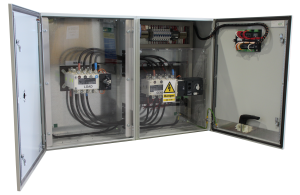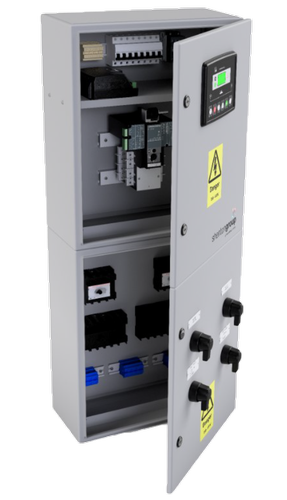An Automatic Mains Failure (AMF) panel, often referred to as an Automatic Transfer Switch (ATS) panel, is a crucial component in any backup power system. If you’ve ever wondered what is an AMF panel, it’s a device that automatically detects mains power failure and seamlessly switches the electrical load to a standby generator. Once mains power is restored, the AMF panel switches the load back to the main supply and safely shuts down the generator after a cooling period.
Without an AMF panel, the switch to generator power must be done manually, risking significant delays, data loss, equipment damage, and business disruption.
How Do AMF Panels Work?
Have you ever wondered how in the event of mains failure Uninterruptible Power Supplies and Standby Generators reinstate power? Automatic Mains Failure (AMF) panels, also referred to as an Automatic Transfer Switch (ATS) are the key.

Power Cut to Power Back in Seconds
An AMF panel continuously monitors the incoming AC mains supply. When a power outage or voltage drop is detected, it automatically starts the backup generator. After a short warm-up period—typically around 15 seconds—it transfers the building’s electrical load from the main power supply to the generator.
When the mains power is restored, the AMF panel initiates a smooth transfer of the load back to the utility power and then shuts down the generator after a controlled cooldown period. This automation ensures that essential operations continue without interruption.
Without AMF panels, organisations would have to manually change over from mains to the generator and therefore suffer a longer break in electricity and depend on personnel being available to carry out this task.
Do I Need an AMF Panel for My Backup Generator?
If your organisation has invested in a backup generator, an AMF panel is essential to maximise its value. Here’s why:
- Automatic Power Switchover: Eliminates the need for manual intervention during power failures.
- Minimised Downtime: Reduces interruption to operations, protecting critical data and equipment.
- Improved Safety and Reliability: Controls the generator with built-in monitoring for speed, oil pressure, water temperature, and fuel levels.
- Peace of Mind: Ensures power continuity whether or not personnel are on-site.
In short, an AMF panel guarantees seamless transition during power loss and is a must-have for any robust power management system.

AMF Panel Manufacturer & Designer
Shenton Group design and manufacturer AMF panels, ensuring that the continuous power solutions we provide operate superfluously, linking ATS, UPS and standby generators in conjunction with Shenton Group’s remote monitoring solutions.
Phoenix2 ATS panel with no Bypass
Phoenix2 ATS panel – Single Bypass
Phoenix2 ATS panel – Dual Bypass
Ensure uninterrupted power supply and optimise your control system with our advanced AMF panels. Designed for seamless integration and reliable performance, our panels offer seamless supply of power, reduced risk of data loss and also protection against electrical damage. Take control of your power management today and experience enhanced efficiency and peace of mind.”
To discuss your continuous power requirements in detail, speak to a member of the UK’s leading technical experts in Standby Power, Uninterruptible Power Supplies and Combined Heat & Power Systems.
What Is the Difference Between ATS and AMF Panels?
Though often used interchangeably, there is a technical difference between AMF panels and ATS panels:
- An ATS panel typically includes a volt-free contact that signals the generator to start or stop, relying on the generator’s own control panel.
- An AMF panel, on the other hand, is more advanced. It includes its own generator controller capable of managing start/stop functions, monitoring engine parameters, and triggering alarms for issues such as low oil pressure or high water temperature.
A key difference between the two is how the generator is started. ATS includes a voltage-free contact that the generator uses to start/stop via its set-mounted control panel, while the AMF includes a generator controller with start stop, speed, oil pressure, water temperature and full level alarms.
Delivery of an AMF Project in Bristol
For IT companies, power continuity is of critical importance. For a project in Bristol, the client required the relocation of an existing 3-phase generator. The new location requirements meant that the existing 3-phase generator had to be modified to support the single-phase load at the new site. The new site conditions meant that the generator also required adaptation to support multiple mains supply.
For each mains supply there was the requirement of an automated transfer switch (ATS) and associated cabling, so the AMF panels can sense mains supply and start the back-up generator, in the event of a failure.
On site, there were two mains supplies to be supported, one of which was split into two, supporting a total of three separate buildings. This allowed Shenton Group to use just two AMF panels keeping costs at a minimum. One AMF was located outside in an IP rated enclosure mounted on a plinth and stand, whilst the other was at high level in the building by the mains header it supported.
Connections to the external AMF were local to the generator. The second cable run was more involved being approximately 60 metres running at high level across one building and then through a cable trench under a drive way to the building it was supporting.
At Shenton Group, we specialise in designing and manufacturing bespoke AMF panels and standby generator systems tailored to your exact requirements. With over 40 years of experience, we are the UK’s trusted experts in standby power, Uninterruptible Power Supplies (UPS), and Combined Heat & Power (CHP) systems.
Ensure uninterrupted power and protect your operations with a reliable AMF panel from Shenton Group. Our panels are built for seamless integration, robust performance, and long-term reliability.
Contact our team today to discuss your power continuity needs and learn more about how our AMF panels can safeguard your critical systems.


